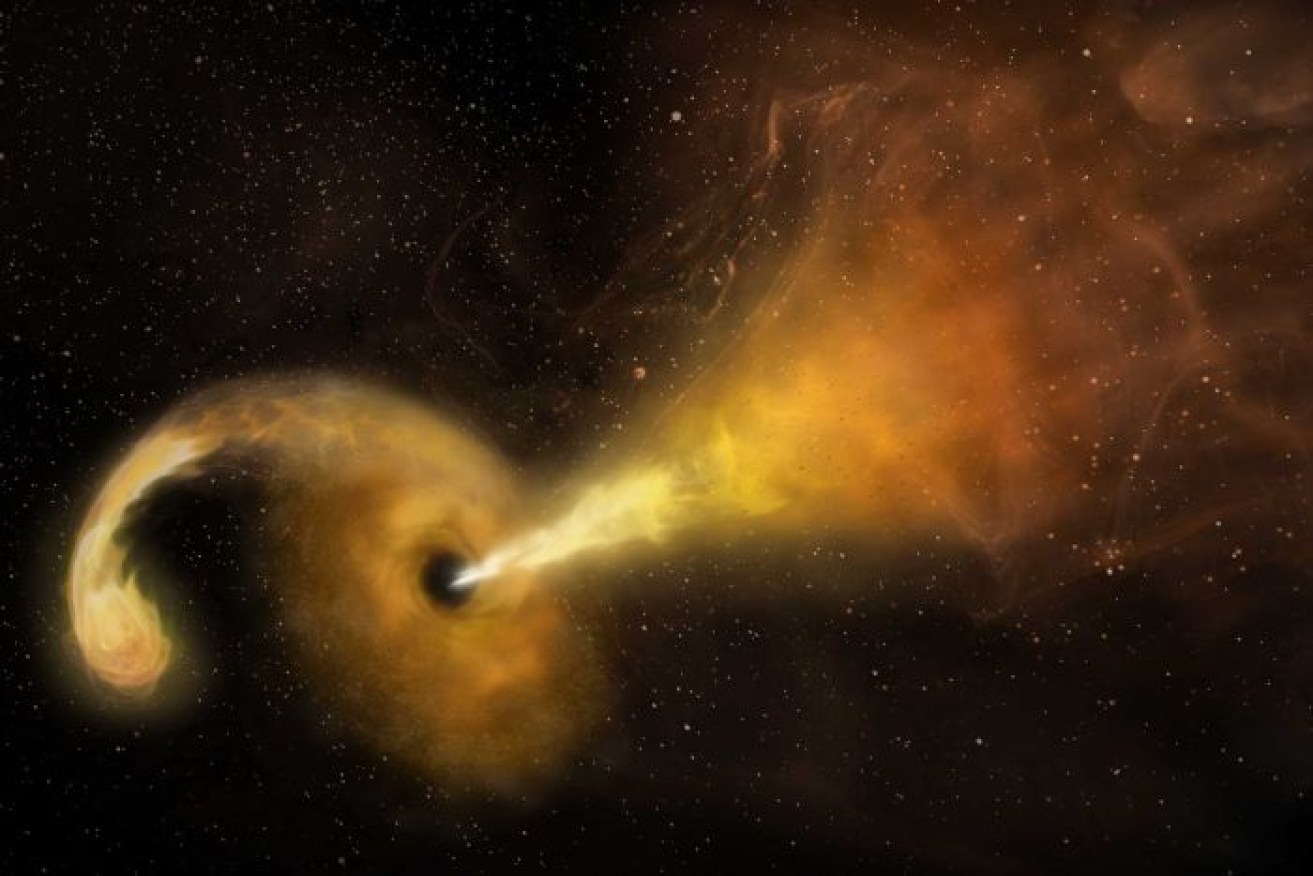Black hole vs star: Astronomers record world first

About half the mass of the star is blasted into space as a radio jet. Photo: Sophia Dagnello, NRAO/AUI/NSF
For the first time, astronomers have captured images of a jet of radio waves blasted into space when a star was ripped apart by a supermassive black hole.
While a handful of tidal disruption events have been detected, none of the previous reports had directly observed a radio jet, Dr Ryder said.
The discovery, published Friday in the journal Science, was not what the astronomers originally set out to find.
At the beginning of 2005, Seppo Mattila of the University of Turku in Finland and his colleagues were scanning a pair of colliding galaxies known as Arp 299, looking for signs of supernovae.
Located about 150 million light years away in the constellation of Ursa Major, aka “The Big Dipper”, Arp 299 is the birthplace of massive young stars that leave huge clouds of dust behind when they explode.
Thanks to the distance and the dust, studying Arp 299 is no easy feat.
“The dust means we need to go to longer wavelengths of light with infrared and even radio waves, which are less affected,” Dr Ryder said.

The astronomers noticed a brightening near the centre of one of the galaxies in Arp 299. Photo: Sophia Dagnello, NRAO/AUI/NSF;NASA,STScl
The astronomers were looking on the outskirts of Arp 299 when they noticed a bright burst of infrared emissions coming from the dusty centre of one of the galaxies.
Six months later, observations of the galaxy using a series of radio telescopes across the US known as the Very Long Baseline Array (VLBA) picked up a new radio signal from the same location.
Dr Ryder, who was also hunting for supernovae, and other astronomers from the 36-strong team, followed up the observations using other telescopes, such as the Gemini-North near-infrared telescope in Hawaii and the Spitzer Space Telescope.
Over time, the infrared and radio signals became brighter.
In 2011, six years after the first emissions were detected, observations showed an elongated jet-like structure streaming from the radio source.
“You have to be lucky when you see it,” Dr Ryder said.
“We were just fortunate that this jet is angled to our line of sight enough that we can actually see it expanding with time.”
Why haven’t we seen this before?
Over the course of 10 years, 100 times the energy seen in a typical supernova explosion was pumped out.
But while changes in the galaxy were detected in the infrared and radio spectrums, optical telescopes could not pick up the event.
“None of our optical telescopes, not even the largest ones on Earth, were able to notice anything unusual in the brightness of the nuclear region in this galaxy,” Dr Ryder said.
“People always expect to see [these tidal disruption events] in the optical wavelengths, but we’ve shown that’s not necessarily going to be the case.”
Janie Hoorman, who was not involved in the research, said the discovery “could mean we were looking in the wrong place for these events”.
“People would typically look at them with optical, UV and X-rays — so the higher energy wavelengths — and not finding as much as they expected,” said Dr Hoormann, an astrophysicist at the University of Queensland.
It is possible that dust created by the exploding stars in this galaxy could absorb the higher wavelengths, re-emitting them at lower energies in the infrared and radio ranges, she said.
“There are a lot of other galaxies that have all of this dust in the way,” Dr Hoormann said.
Knowing how frequent these events are could provide some insight into what impact the energy created in these massive explosions has on the development of galaxies.
The researchers said the findings indicated that these violent star deaths could be much more common, but go unseen in dusty galaxies.
“These things can happen and many of our telescopes on Earth would be completely blind to it if they only looked at the optical range,” Dr Ryder said.
New telescopes being developed such as the Large Synoptic Survey Telescope, which are designed to scan the sky every two to three nights, could help identify more tidal disruption events.
“But the problem is most of [the new telescopes] will only observe at optical wavelengths,” Dr Ryder said.
Dr Ryder is now involved in a collaboration being led by the Australian National University to develop a telescope called DREAMS (Dynamic REd All-sky Monitoring Survey), that can map the southern sky in the infrared spectrum.
“So hopefully we won’t miss any such events.”
-ABC








